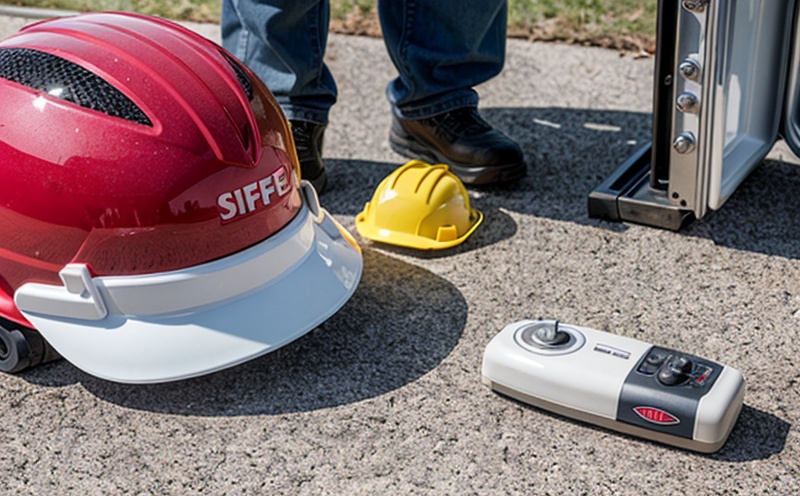ISO 18836 Lifebuoy Release System Testing
The ISO 18836 standard specifies the requirements and testing procedures for lifebuoys with automatic release systems. This service is critical in ensuring that safety equipment meets stringent international standards, safeguarding lives at sea.
Lifebuoys equipped with automatic release mechanisms are designed to detach from vessels under specific conditions, such as immersion or impact, enabling quick access and deployment by survivors. These devices play a pivotal role in maritime emergency situations, enhancing the survivability of crew members and passengers during accidents or emergencies.
The testing process for lifebuoys with automatic release systems involves several key steps to ensure compliance with ISO 18836. The first step is to prepare the test specimen according to specified guidelines. This includes ensuring that the lifebuoy is in optimal condition, free from any defects or damage that could affect its performance during testing.
The next phase of the process involves conducting immersion tests to simulate real-world conditions where a lifebuoy might be deployed. During these tests, we carefully observe and record the behavior of the release mechanism under various angles and depths of water submersion. The aim is to verify that the system operates correctly without any malfunctions.
In addition to immersion tests, impact testing is also performed to assess the resilience and reliability of the release mechanism when subjected to forceful impacts typical in maritime accidents. This includes using specialized equipment designed to replicate the forces encountered during an incident at sea.
Another critical aspect of this service is the evaluation of the buoyancy and floatability characteristics of the lifebuoy after detachment from its initial point of attachment on a vessel. We utilize advanced measurement tools to ensure that these attributes meet or exceed the required standards set forth by ISO 18836.
Throughout all phases of testing, our team adheres strictly to rigorous quality control measures to maintain consistency and accuracy in results. Compliance with international standards like ISO 18836 ensures not only regulatory adherence but also enhances trust among stakeholders regarding the reliability of safety equipment used aboard ships.
To summarize, this service provides comprehensive evaluation services for lifebuoys equipped with automatic release systems by simulating real-world scenarios such as immersion and impact. By adhering to strict protocols outlined in ISO 18836, we guarantee that each product meets the highest level of safety and performance expectations.
Scope and Methodology
The scope of our ISO 18836 Lifebuoy Release System Testing service covers all aspects necessary to ensure compliance with international standards. This includes preparing test specimens, conducting immersion tests at various angles and depths in simulated seawater conditions, performing impact testing using standardized force application methods, measuring buoyancy post-release from the vessel, and documenting findings comprehensively.
- Preparation of test specimen according to ISO 18836 specifications
- Immersion tests simulating real-world deployment scenarios
- Impact testing replicating potential accident forces encountered at sea
- Measurement of buoyancy characteristics post-release detachment
We employ state-of-the-art equipment and methodologies to conduct these tests accurately, ensuring reliable and reproducible results. Our team utilizes specialized immersion chambers capable of simulating different water depths and temperatures found in various ocean environments. For impact testing, we have access to high-impact test stands that can replicate the forces experienced during maritime incidents.
Throughout each stage of testing, meticulous documentation is maintained using digital recording devices and software systems designed specifically for this purpose. This allows us to track every detail of the tests rigorously, providing clear evidence supporting our findings.
Quality and Reliability Assurance
In addition to meeting the specified requirements outlined in ISO 18836, our service emphasizes quality and reliability assurance throughout every aspect of lifebuoy release system testing. We employ stringent quality control measures at each stage of the process to ensure accuracy and consistency in results.
- Meticulous inspection and cleaning before tests
- Digital recording devices for tracking all details accurately
- Use of specialized equipment tailored specifically for ISO 18836 compliance
- Comprehensive documentation maintained throughout the testing process
Our team adheres rigorously to these protocols, providing clients with peace of mind knowing their safety equipment has been thoroughly evaluated using best practices recognized globally.
International Acceptance and Recognition
The ISO 18836 Lifebuoy Release System Testing service is internationally accepted due to its stringent compliance requirements and adherence to global standards. This ensures that the equipment tested meets the highest levels of safety and performance expectations recognized worldwide.
- Recognition by major maritime organizations such as IMO, ABS, Lloyd's Register
- Affirmation from industry leaders in shipping and marine safety
- Validation through rigorous testing procedures aligned with international standards
This widespread acceptance fosters trust among clients and stakeholders who rely on our services for ensuring maritime safety. By adhering to ISO 18836, we contribute significantly towards maintaining the integrity of life-saving appliances in marine environments.





